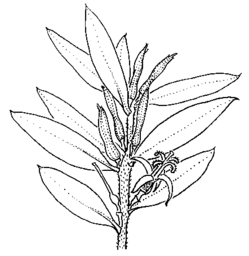Persoonia oleoides L.A.S.Johnson & P.H.Weston APNI* Synonyms: Persoonia oxycoccoides var. longifolia APNI*

Description: Erect to decumbent shrub, young branchlets moderately to densely hairy.
Leaves oblong to elliptic to ovate or obovate to ± spathulate or very rarely broad-elliptic to broad-ovate, mostly 2–6 cm long and 4–15 mm wide, flat, with ± recurved margins, sometimes incurved, sparsely hairy when immature (but denser on margins), glabrescent to sparsely so when mature on the upper surface, smooth to slightly scabrous.
Inflorescences terminated by a dormant bud or growing on into a leafy shoot; flowers subtended by scale leaves or leaves; pedicels mostly 1–3 mm long, erect, moderately to densely or rarely sparsely hairy. Tepals 10–15 mm long, acuminate to shortly caudate, moderately hairy. Ovary glabrous or rarely sparsely hairy.
Distribution and occurrence: in dry sclerophyll forest to wet sclerophyll forest, on various metamorphic and igneous substrates, from the upper Clarence R. to the upper Macleay R.
NSW subdivisions: NC, NT
P. oleoides forms a narrow hybrid-zone with P. cornifolia; it also hybridizes rarely with P. media where they grow together.
Text by P.H. Weston
Taxon concept: P.H. Weston (1995)
APNI* Provides a link to the Australian Plant Name Index (hosted by the Australian National Botanic Gardens) for comprehensive bibliographic data
***The AVH map option provides a detailed interactive Australia wide distribution map drawn from collections held by all major Australian herbaria participating in the Australian Virtual Herbarium project.
|


